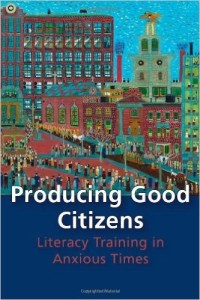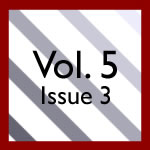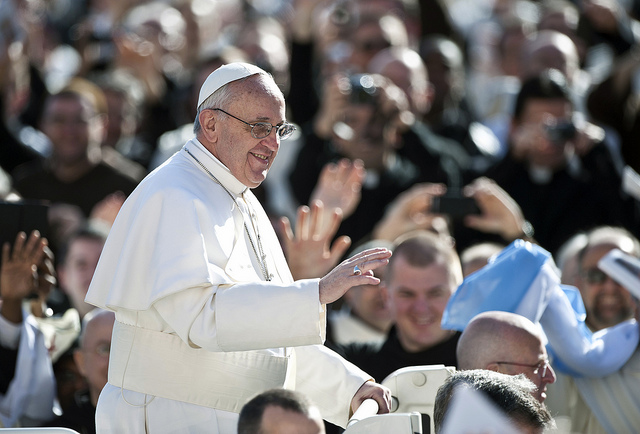Book Review: Wan’s Producing Good Citizens
Wan, Amy J. Producing Good Citizens: Literacy Training in Anxious Times. Pittsburgh: U of Pittsburgh P, 2014. Print.
 Through its analysis of three very different sites of education in the early twentieth century, Producing Good Citizens provides an important addition to historical discussions about literacy training, its approaches, and its implicit and explicit values. The book provides more than historical discussion by also comparing these three early twentieth-century models of literacy training with contemporary approaches. At first glance, the historical sites Wan analyzes—immigrant education programs, union-sponsored worker education, and college writing courses—may appear as different from one another as they do from literacy training sites within contemporary higher education. Wan shows how these sites compare with one another and with current models of literacy training in one key characteristic: the invocation of citizenship production to justify their work; however, these education programs from the past differ from one another and from current education approaches in how they define “citizenship,” generally allowing that definition to remain unstated and unquestioned. Wan argues that in contemporary education, this has resulted in an “ambient awareness” of citizenship that assumes value-neutral goals of many common approaches to writing instruction, such as service-learning and public participation curricula like letter-to-the-editor assignments. Partly to prompt readers to question assumptions about such contemporary approaches, Wan examines historical sites of literacy training that invoked the production of citizens and that are very clearly not value-neutral. This historical examination also provides a context for how we came to connect literacy training with citizenship production.
Through its analysis of three very different sites of education in the early twentieth century, Producing Good Citizens provides an important addition to historical discussions about literacy training, its approaches, and its implicit and explicit values. The book provides more than historical discussion by also comparing these three early twentieth-century models of literacy training with contemporary approaches. At first glance, the historical sites Wan analyzes—immigrant education programs, union-sponsored worker education, and college writing courses—may appear as different from one another as they do from literacy training sites within contemporary higher education. Wan shows how these sites compare with one another and with current models of literacy training in one key characteristic: the invocation of citizenship production to justify their work; however, these education programs from the past differ from one another and from current education approaches in how they define “citizenship,” generally allowing that definition to remain unstated and unquestioned. Wan argues that in contemporary education, this has resulted in an “ambient awareness” of citizenship that assumes value-neutral goals of many common approaches to writing instruction, such as service-learning and public participation curricula like letter-to-the-editor assignments. Partly to prompt readers to question assumptions about such contemporary approaches, Wan examines historical sites of literacy training that invoked the production of citizens and that are very clearly not value-neutral. This historical examination also provides a context for how we came to connect literacy training with citizenship production.
Though her goals are daunting, Wan succeeds at both examining the past and considering what it can tell us about the present. She delivers a highly interesting analysis of three very different historical sites of literacy training. This alone provides an extremely valuable contribution to writing studies, particularly since the sites differ from those at the center of other, similar historical analyses that mainly focus on college-based instruction. Further, Wan successfully encourages readers to reflect on contemporary approaches to teaching writing and specifically on the invocation of citizenship production as rationale for civically engaged pedagogy. Some readers might find themselves wanting more direct advice about civic engagement and writing courses—as in, “so, should I do service-learning or not?”—but providing this type of advice is not Wan’s goal. She neither discourages nor champions any approach to writing instruction but effectively calls readers to pause and reflect on citizenship and its treatment in our classrooms. Wan begins by establishing an important theme that runs throughout the book: though not an identical match, the United States of the 1910s and 1920s has much in common with the United States of today, particularly in the invocation of citizenship to deal with its anxieties and uncertainties. Further, then and now, literacy forms a major part of how we decide who our citizens are and what they should be. Wan writes: “ . . . what the previous moment and our current one share is profound economic change and the uses of education through literacy as a mass strategy to shape citizenship” (3).
In her introduction, Wan places her research within the larger context of rhetoric and composition histories from scholars such as James Berlin, Robert Connors, Sharon Crowley, David Gold, Charles Paine, and Kelly Ritter (10). She argues that beliefs about literacy and literacy instruction can tell us much about how we define citizenship and the citizen or, in other words, who belongs and who does not. This is true, she argues, both in the WWI-era and contemporary United States. Work like Berlin’s Rhetoric and Reality: Writing Instruction in American Colleges, 1900-1985 and Connors’s Composition-Rhetoric: Backgrounds, Theory, and Pedagogy connects writing instruction and literacy skills with broader institutions and movements. Like Berlin and Connors, Wan “take[s] up the idea that literacy becomes defined, shaped, and distributed in ways that mediate the relationship between the sponsoring institution and larger social trends” (11).
Wan diverges from Berlin and Connors by including citizens who are not college educated, a move that allows her to consider how citizenship is defined differently for a greater variety of people, including those who do not have access to or simply do not go to college. Like Anne Ruggles Gere in Intimate Practice: Literacy and Cultural Work in US Women’s Clubs, 1880-1920, Wan includes in her study the extracurricular spaces for literacy and literacy instruction. Doing so, she argues, allows her to “unpack the consequences of acquiring literacy for students who were not ‘mainstream’ college students” (12). By including these extracurricular sites of literacy training, as Gere and other scholars do, Wan analyzes the specific practices used to shape different groups into carefully constructed types of citizens based on their “citizenship potential” (13). This potential, based on factors like background, race, class, and gender, further determines the groups’ opportunities and access to resources (12-13).
In her study, Wan raises several important questions about citizenship, literacy, opportunity, and access. She questions how citizenship is defined in classrooms and other sites for literacy training, what are the consequences when “these definitions remain unspoken,” and why we invoke literacy as a tool for acquiring citizenship and its many opportunities (13). She addresses these questions through investigation of three locations of literacy training from 1910-1929: government-sponsored Americanization programs for immigrants, union-sponsored education programs for workers, and college writing courses. The third category will look the most familiar to rhetoric and composition scholars, many of whom will have read similar research from Berlin, Connors, and other historians of college writing instruction. While many readers will have considered the role college writing instruction has historically played in sorting students, Wan’s inclusion of extracurricular sites of literacy training shows how categorization has occurred on a larger scale, including for individuals who never saw—or never even planned to see—the inside of a college classroom. By juxtaposing these three very different sites, each with very different sponsors and students, Wan shows how literacy training is used to sort different groups of people according to their citizenship potential, or in other words, the extent to which they can become full citizens who enjoy all the benefits of US citizenship. Wan argues: “Citizenship and literacy operate together to persuasively categorize, sort, and credential individuals” (15).
In chapter 1, Wan establishes the historical and theoretical framework for the study. To begin, she points to what she calls the “ambient nature of the use of the term ‘citizenship,’” or the unarticulated, unexamined assumption that the writing classroom should cultivate good citizens (and that, further, we all agree on what defines the “good citizen”). Those who have been reading the book as only a historical study to this point may feel jarred, in a positive way, by Wan’s discussion here. Wan refers to approaches to writing instruction popular now—such as service-learning and letter-to-the-editor assignments—that invoke the cultivation of engaged citizens as a goal. Referring to the work of Ellen Cushman, Michele Simmons, Jeffrey T. Grabill, Linda Flower, Eli Goldblatt, Christian Weisser and others, Wan describes recent movements toward the “writing classroom as training ground for active and participatory citizenship” (21). While she does not find fault with these movements per se, Wan argues that the unexamined goal of producing better citizens results in an “‘ambient awareness’ of citizenship . . . that obfuscates the range of citizens’ rights, obligations, and privileges” and pretends that participation is all that’s required to be a full US citizen, with all the accompanying privileges (21).
Further, Wan argues that the connection between literacy and citizenship should not go uninterrogated. Again, despite the historical nature of Wan’s study, she makes this argument directly relevant to current teachers, some of whom might pick up the book assuming that they will be only looking back instead of examining their current practices. When she writes that “[a] classroom that emphasizes critical thinking, argumentation, Web 2.0, and service-learning . . . reveals a teacher’s commitment to a particular approach to citizenship,” readers who teach will find themselves reflecting on how they define citizenship in their classrooms, what types of citizens they are trying to produce, and how they use literacy to construct a particular version of citizenship and citizens. This is a powerful rhetorical move on Wan’s part, one that makes the historical discussion in the next several chapters more relevant for current readers.
Wan’s discussion in chapter 1 becomes even more powerful when she argues that when we make assumptions about citizenship and literacy training, we can overlook important inequalities, instead buying into uncomplicated narratives about achieving opportunity and access by working hard, succeeding in literacy learning, and becoming better citizens. Wan states: “But literacy not only brings about healthier citizenship, it can also reinforce the legal, economic, and cultural exclusions that already exist, which can go unacknowledged and should be made more visible in citizenship-producing efforts” (35). Wan’s argument helps further important discussions about publicly engaged writing instruction by showing that we cannot rely solely on “cultivation of good citizens” as rationale for our work, at least not without considering how we define “good citizens.”
After establishing the study’s historical and theoretical framework in chapter 1, Wan focuses chapters 2-4 on three distinct sites of literacy training in the early twentieth century. Chapter 2 examines efforts to Americanize immigrants through literacy and citizenship classes and training materials like the Federal Textbook on Citizenship Training. Wan argues that these efforts equated literacy with productivity, a move that allowed for shaping citizens in ways that would most benefit the American economy and ease anxieties about immigration. Chapter 3 investigates literacy training programs organized by two labor unions, the Workers’ Education Bureau and the International Ladies’ Garment Workers Union (ILWGU). Where federal Americanization programs positioned literacy as a tool for individual productivity, union-sponsored education emphasized literacy as a tool for collective action. Because literacy was already used in “the era’s common discourse of citizen-making,” invoking literacy provided union education organizers a more palatable method of furthering the labor movement than more radical measures (73). Importantly, the definition of “literacy” is not the only one at stake. In comparing government-sponsored and union-sponsored education programs, Wan also shows that the definition of “citizen” varies. In the former, students are potential citizens of the United States; in the latter, students are shaped into “good citizens of the labor movement” (14).
In chapter 4, Wan examines literacy training in higher education. As in the previous two chapters, she focuses on definitions of citizenship and literacy as well as on how citizen-making through literacy training was used to quell anxieties in American society during the early twentieth century. Drawing on educational historian David O. Levine’s argument that a “culture of aspiration” shaped higher education during this time, Wan argues that in the university, literacy training focused on middle- and upper-class stability and mobility (114). Like rhetoric and composition historians before her, Wan shows how college English courses became tied up in teaching much more than literature and writing. This occurred partly because of anxieties surrounding who could be credentialed as middle and upper class via a college education.
In the final chapter, Wan turns her attention to the present, considering a number of current trends and policies related to the production of literate citizens. She argues that comparing contemporary and past uses of literacy to address anxieties about citizenship can help us better understand “the implications of changing economic opportunities on our present expectations for citizenship” as well as “how educators are managing those expectations in the writing classroom in efforts to create literate citizens” (148).
In earlier parts of the book, Wan encourages readers to think deliberately about using “the production of good citizens” as a rationale for literacy teaching. In this final chapter, Wan makes this argument more directly and more urgently. She writes: “The values that we impress upon our students when we make calls for citizenship are not neutral, and this should be acknowledged and carefully considered” (147). Wan discusses recent immigration legislation, including the DREAM Act, to illustrate the complexity of how citizenship is both legally and culturally defined. Wan concludes by asking instructors “to pause and reconsider what is behind the often rote invocations of citizenship that provide the backdrop for so much of the work we do” (178). She asks readers to replace these “rote invocations” into more thoughtful practices that take into account the legal, economic, and political realities beyond our classrooms that shape the production of citizens.
Readers will come away from the book with a better understanding of how the production of good citizens came to be such a common educational objective as well as how citizenship and literacy came to be so tightly bound in a variety of educational spaces. Additionally, the book helps complicate current rationale for many popular approaches to teaching writing, such as service-learning and participatory assignments written for “real” public audiences and purposes. Ten years after Paula Mathieu examined composition’s public turn in Tactics of Hope, such approaches to teaching writing are still going strong in colleges and universities. Taking a thoughtful, critical attitude to such teaching approaches might perhaps be more necessary than ever, then, given their sheer popularity as well as the temptation to assume that such generally well-intentioned efforts are always positive.
To enact Wan’s suggestions for greater deliberation, readers need not abandon teaching approaches that seek to cultivate better citizens through the study of literacy. Rather, readers can question—with themselves, with students, and with other educators—what we mean when we say “citizen” and how literacy plays a role in granting citizenship and sorting people. That Wan helps to raise these questions and provides historical context for discussing them makes Producing Good Citizens an extremely valuable contribution to writing studies.
Works Cited
- Berlin, James A. Rhetoric and Reality: Writing Instruction in American Colleges, 1900-1985. Carbondale: Southern Illinois UP, 1987.
- Connors, Robert J. Composition-Rhetoric: Backgrounds, Theory, and Pedagogy. Pittsburgh: U of Pittsburgh P, 1997.
- Gere, Anne Ruggles. Intimate Practices: Literacy and Cultural Work in US Women’s Clubs, 1880-1920. Urbana: U of Illinois P, 1997.
- Levine, David O. The American College and the Culture of Aspiration, 1915-1940. Ithaca, NY: Cornell UP, 1986.
- Mathieu, Paula. Tactics of Hope: The Public Turn in English Composition. Portsmouth, NH: Boynton/Cook, 2005.
- Wan, Amy J. Producing Good Citizens: Literacy Training in Anxious Times. Pittsburgh: U of Pittsburgh P, 2014.




 Jaclyn Wells is an assistant professor of English and writing center director at the University of Alabama-Birmingham. Jaclyn’s work has appeared in the Community Literacy Journal, Reflections, WPA: Writing Program Administration, and various edited collections. Jaclyn’s co-authored book manuscript (with Allen Brizee), Partners in Literacy: A Writing Center Model for Civic Engagement, is forthcoming.
Jaclyn Wells is an assistant professor of English and writing center director at the University of Alabama-Birmingham. Jaclyn’s work has appeared in the Community Literacy Journal, Reflections, WPA: Writing Program Administration, and various edited collections. Jaclyn’s co-authored book manuscript (with Allen Brizee), Partners in Literacy: A Writing Center Model for Civic Engagement, is forthcoming.